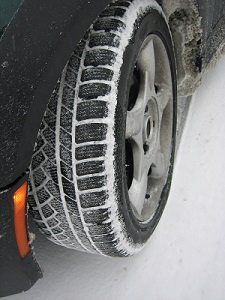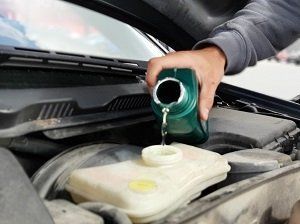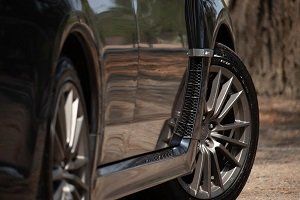Call Us
Business Hours
Loading ...
Missing business hours data / Error occurred while getting the data.
Loading ...
Missing business hours data / Error occurred while getting the data.
Blog

By KUKUI Administrator
•
October 6, 2022
In a lot of parts of the country, the winters are tough enough that all-season tires just won’t get the job done. All-season tires are a compromise; they offer good year-round traction with a quiet ride, good handling and road manners. They tend to perform well in wet weather and light wintry conditions, but when the snow is more than a couple of inches deep, all-season tires are out of their league. That’s when it’s time to consider winter tires. Today’s winter tires are a long way from the heavy, noisy, clumsy “snow tires” or “mud grips” that your dad might have had on his station wagon 40 years ago. Modern winter tires are designed for noise, handling, steering response and road manners that rival grand touring tires, only with enhanced traction. They accomplish that with deeper, more aggressive tread grooves and a tread pattern that’s designed to eject snow and slush for a clean “bite” with every revolution of the wheel. More importantly, the tread compound used for winter tires is substantially different. Grand touring or all-season tires can stiffen at low temperatures, reducing traction. Winter tire formulations are designed to stay flexible even when temperatures are at zero or below, meaning they can still deliver traction in winter conditions. Some winter tires come pre-drilled for studs, which can enhance traction even more in snow and light icy conditions. There are a few things to remember with winter tires, however: • Winter tires often don’t handle as precisely as all-season tires, due to their construction. That may not matter much in snow, when handling will be sloppy and treacherous anyway, but it can be a noticeable difference on dry pavement. • Winter tires tend to be noisier • Winter tires are rather fragile. That same soft rubber compound that helps with traction in snow means that the tires will wear down much more quickly in warmer temperatures. For that reason, winter tires should not be used when temperatures are above 35-45 degrees. • If you elect to go with winter tires, you’ll need to get an entire set and not just a pair. Mixing designs of tires can result in poor traction, uneven and unpredictable performance and a “schizophrenic” car. With all that in mind, you’re going to be the best judge of whether you really need winter tires or not. If your part of the country gets a few inches of snow that typically melts in a few days or a week, when the weather changes, winter tires might not be a real necessity. If you’re in a place like the upper Midwest, New England or the mountains, with snow measured in feet rather than inches and winter temperatures that stay below freezing for weeks on end, winter tires might be a good investment after all. If you’re leaning that way on the decision, call us and let us get you the best deal on quality winter tires that you’ll find anywhere!

By KUKUI Administrator
•
August 11, 2022
Summer is the season for travel to new destinations with your family, friends, or in your own company. Being prepared is important to ensure your trip goes as smoothly as possible. From a pre-trip inspection for ensuring your vehicle is ready to hit the road, to being prepared for the unexpected during your travel, the team at Wastler Tire Pros has outlined some important steps to take to before you hit the road. Inspect Your Spare Tire Always check your spare tire to ensure that it is in good condition and properly inflated. Overtime tires can deflate and with this being stored away in your vehicle it may be overlooked as one of the important pieces to check before you begin your travel. Add A Roadside Emergency Kit Add a roadside ready kit into your vehicle so you are prepared for the unexpected. These are very cost-efficient and many versions can be found on Amazon or at your local big-box stores such as Walmart or Costco. These kits normally contain jumper cables, road flares, and other essentials in the event that your vehicle experiences issues during your travels. Check out this Emergency Roadside Kit from Amazon Get a Pre-Trip Inspection Stop by and see us at 4174 Ridge Rd. | Westminster, MD 21157 and get a pre-trip inspection. During this inspection specific components of your vehicle with be reviewed and repair recommendations may be made before you hit the road. Some of the items we may review are: Tire pressure Car battery Fluids Wiper blades We hope that you have fun this summer on your travels and that you will allow our team to help keep you on the road.

By KUKUI Administrator
•
July 2, 2021
Your vehicle's oil change is a simple service with high importance. Oil change services are vital to the overall operation of your car because it helps to ensure the overall health of your vehicle's engine. Low or dirty motor oil can lead to heat damage, corrosion, and metal-to-metal contact between parts. Engine repairs can be costly, so it is best to avoid major engine troubles by staying on top of your car's regular oil changes. Oil changes are an essential part of owning a car. Clean engine oil circulates throughout your vehicle's engine to lubricate components and regulate heat. It also helps to carry dirt and debris back through the oil filter to prevent grime build-up over time. Oil quality, car age, and how the car is driven on a day-to-day basis are a few factors that can affect how often your car may need an oil change. Check your owner's manual for specific recommendations for oil changes. Visit your auto repair shop for quality oil changes and fluid check-ups that meets your vehicle manufactures specifications. Signs That Your Car Might Be Due for Oil Change Service Engine oil provides lubrication to keep your expensive engine running smoothly and prevent excessive wear. An oil change is an effective and inexpensive way to help protect the life of your car. Regular oil changes can help optimize your car, truck, or SUV's performance and fuel economy. The following are warning signs that your vehicle needs an oil change and filter replacement. • Your dashboard check engine or oil light is on • Your engine makes grinding, tapping, or knocking noises • You see dark, dirty oil on the dipstick • You smell oil outside your vehicle • There's dark smoke coming from your vehicle's tailpipe • You notice oil leaks on the ground under your vehicle Schedule an Appointment for Oil Change Service Near You! When you need an oil change service, visit an auto repair shop near you. Regular oil and filter changes are significant to the life of your engine. It helps keep your vehicle's engine clean, reduces overall wear, and maximizes its performance. Keep up with all your auto repair services to keep your vehicle safe. Schedule an appointment for your next oil change service today!

By KUKUI Administrator
•
June 10, 2021
The power steering system relies on several mechanical parts. Power steering systems function to provide easier manoeuvrability and a better degree of control over the vehicle, making driving all the more effort-free. It is sometimes referred to as the steering assist system or SAS. Without it, steering would be physically strenuous and challenging to perform. Power steering systems can either be hydraulic, electric or a combination of the two. Steering a vehicle involves getting its front wheels to turn synchronously, either to the left or right. This is achieved with the help of different gear systems. The two main steering gear systems are the rack and pinion and the recirculating ball steering gear. The power steering system uses intermediate electric or hydraulic devices to reduce the effort necessary to steer the front wheels of the vehicle side to side. It multiplies the force applied by the driver through the steering wheel to achieve a smooth and quick directional change of the vehicle. Your car will respond immediately to even the smallest of adjustments you make, and it is easier to stay in your lane when you're driving in traffic and carrying out complicated parking manoeuvres. How Does Hydraulic Power Steering Work? Hydraulic power steering uses fluid to intensify the force applied to turn your front wheels. The hydraulic fluid is pressurized by a pump driven off the engine, which provides hydraulic pressure to the steering system. When you turn the steering wheel, hydraulic pressure is applied to your steering gear, which turns your wheels. The whole system relies on the flow of fluid. The harder you turn your wheel, the more fluid flows to the hydraulic cylinder, so the more force is applied to your wheels. How Does Electric Power Steering Work? The electric power steering uses an electric motor that draws energy from the vehicle's electrical system to provide steering assistance. Sensors detect the torque or effort that the driver is applying at the steering wheel, and a computer decides how much assist needs to be added. The major benefit of electric power steering over hydraulic power steering is that they can adapt to suit specific driving conditions. Avoid issues such as a power steering leak with a vehicle inspection from an auto repair shop. It's one of the best ways to ensure your power steering system and the rest of your vehicle's vital components can perform at their best. If you're finding it harder to turn than usual, then there's probably an issue with your power steering. Your steering should be effortlessly responsive. Schedule an appointment or bring your vehicle to an auto repair shop near you for power steering service.

By KUKUI Administrator
•
May 15, 2021
Determining your tire age is very important for your driving safety. Driving with a tire over six years old could be putting you and your passengers in danger. Tires dry rot with age from the inside out. When the tire gets older, it is exposed to the elements, and the strength of the bond between the rubber and the steel belts is reduced. This can cause cracks in the rubber, which may appear on the tire’s surface and can also appear out of sight within the structure of the tire. Keeping a record of your tires and understanding their age will help you save money on repairs and take proper care of your vehicle. Driving on damaged tires is extremely dangerous and can lead to a fatal accident. It is recommended that drivers have a professional auto mechanic inspect all tires that are in use for six years or more to ensure they are still safe for use. Proper tire maintenance will also help to keep your tires working effectively and lasting longer. Keep up with tire rotation, tire repairs, tire balancing, and wheel alignment services to avoid premature tire wear. How Can I Tell the Age of a Tire? The age of your tire can be identified by an imprinted coded date that indicate when that tire was manufactured. The four-digit tire code is usually located on the tire sidewall. The tire serial number is the best way to determine how old a tire is. The serial number is sometimes called a DOT Code. This code offers information on who manufactured the tire, where it was made, and other tracking information. It also indicates that the tire has passed the legal manufacturer requirements. An example of a tire manufacture DOT code is 4718. • The first 2 digits are the week. • The last 2 digits are the year. • In this example, the tire was made in the 47th week of 2018. If you have a tire with a 3-digit number in the serial number, it was manufactured before the year 2000, and you should replace it regardless of tread depth. Your tire can become brittle over time, increasing the chances of a blow-out. Tires are considered to be “new” and suitable for retail sale for up to 5 years from the original date of production with proper storage. To check for the serial number of your tire to determine its age, you can remove the tire or ask your service professional or tire shop. Every tire has a birthday, and we advise you to have your tire checked regularly by a professional to make sure they are safe for continued driving. Install new tires regardless of appearance, mileage, or actual wear, once they reach ten years of age.

By KUKUI Administrator
•
May 13, 2021
It has happened to most of us. We're on our way to school or work, and we hear that dreaded sound of a flat tire or a blowout. Some sort of debris in the road has left you with a damaged tire and an immobile vehicle. This situation always brings on frustration. Now you must deal with getting your car to a tire repair shop. The tire has to be properly assessed to perform the necessary repair or replacement service. Depending on where the puncture is located and the severity of the damage, the tire will either only need a simple repair or be replaced. Tires are crucial to the safe performance of our vehicles. For the continued safety of your car, mechanics must utilize the best possible way to fix your tire . The availability of options leads to some debate over what is the "best" way to fix a tire and keep your vehicle safe. Is a plug repair sufficient, or do I need to replace the tire? Here are some considerations to determine which tire repair method is the best option for you. When is Tire Plugging an Option for Tire Repair? A tire plug is performed using malleable rubber that when inserted into a puncture will expand and trap air from getting out. Tire plugging should be a temporary fix for a damaged tire and not a permanent solution for proper tire repair. It is safe to drive with a tire plug for a short time, as the intent of the repair is to allow the car to be drivable so that you can reach the tire store. A plug can only be used on small holes — those up to ¼ inch in diameter. Tire plugs should only be used on the tread of the tire, not on or near the sidewalls. When to Replace a Damaged Tire? Nobody wants to replace a new tire or a tire with plenty of tread still left. But the reality is that our safety should always come first. Your tires are your most important automotive part and the only automotive part that touches the road. The deciding factors on whether a tire can be repaired depend on how much damage has occurred and where the damage is located. The following situations will always warrant a new tire: • Any damage to the shoulder or sidewall of the tire • Large holes anywhere in the tire of more than ¼" in diameter • Evidence of any severe damage, such as tread separation or large gashes • The tire is damaged in a previously repaired area The most important thing to remember is that any tire damage is a safety hazard and should be dealt with immediately. Your tires need to be checked and maintained regularly for damage, wear and tear, and lifespan. Replacing damaged tires is always safer, but some tire damage can be safely repaired to give you thousands of miles more use from your tire.

By KUKUI Administrator
•
March 11, 2021
Your vehicle should always drive straight and true. If your car veers to the right or left, there could be several possible causes — some more severe than others. The problem doesn’t always have an obvious cause. There could be an issue with tires, wheel balance, and other factors that can cause the vehicle to drift. You will need the help of an expert auto mechanic to properly diagnose the problem. It is hard to focus on safe driving when you’re constantly tugging your wheel so you can keep it straight. Not only is this inconvenient, but it’s also dangerous. We can narrow down the possibilities by looking at some of the issues that can cause this particular problem. The following are the most common culprits of why your car veers to the side. Wheel Alignment If your wheel alignment is off, this can cause your vehicle to pull to one side and can also cause uneven wear on your tires. This the most common cause of your car veering to one side. This happens overtime due to poorly maintained roads and hitting the curb. It's a good idea to periodically get a wheel alignment check for your vehicle at a service center and then have it realigned as needed. When your vehicle is properly aligned, it is at optimal performance, and your steering wheel is centered. Tires Your tires have direct contact with the road, and they should follow the direction you steer in. Uneven wear or low tire pressure can cause a vehicle to pull to the right. Not performing tire rotation regularly can cause the wear on your tires to become uneven, which can, in turn, cause your vehicle to pull to one side. Check your tire’s pressure and have your wheels rotated. Brakes Brakes issues can cause your car to pull to one side or the other during braking. This can be due to a damaged brake component or unevenly worn brake pads/rotors. Failure to properly clean, maintain, and repair your brakes can reduce the brake force, which can cause your car to veer. Suspension If a component within the suspension system is damaged or malfunctioning, this will cause one side of the car to pull. The suspension system connects the wheels to the vehicle. It ensures you have comfort, handling, and safety. If the suspension is compromised, it may lead to shaky handling, pulling to one side, vibration, premature tire wear, and an overall dangerous drive. Our automotive technicians can quickly and effectively diagnose and address unwanted pulling issues, ensuring your safety and control. We can determine the source of the problem and recommend the right repairs. As with any automotive issue, it's better to deal with this kind of concern early before it develops into something much more significant and costly to repair.

By KUKUI Administrator
•
February 11, 2021
Tires should never be neglected. The safety of your vehicle depends on it. Your car’s brakes, along with the tires, are two of the most crucial components of your vehicle. Ensuring you are driving a safe vehicle is important not only for your own safety but for other people on the road as well. Having a tire safety checklist is an important part of making sure you are driving a safe vehicle. When you get behind the wheel, especially to travel long distances, you should perform a quick safety check on your vehicle, including an inspection of your tires. Regularly check your tire safety and maintenance checklist for some of the common issues your tires can have. Tires take more abuse than almost any other component of your automobile. They have direct contact with the road and all its elements that may cause them to wear, lose pressure, or puncture. Your tires may be easily inspected for wear and damage. How well you maintain your tires will impact your safety, vehicle performance, fuel efficiency, and repair costs. Here are four important things to check to keep your tires safe. Tread Depth Having a sufficient tread depth is vital to ensure that your car can grip the road properly. Your tires should have a minimum safe tread depth of 2/32 of an inch, or roughly enough tread to completely cover Lincoln's head on a penny when held upside down between the ribs of your tire. Tread depth is important to ensure safety when accelerating or braking, especially in slippery or wet conditions. Tire Air Pressure All your tires should have the correct air pressure. Under- or over-inflated tires can cause erratic vehicle behavior and affect handling and grip, which can be dangerous while driving. Proper pressure in your tires will ensure you have a smooth ride, improve traction, better handling, and optimum fuel economy. Rotation, Balance, and Alignment Keeping up with your manufacturer’s recommended tire services is necessary for the efficiency of your tires. You can follow the service intervals or pay attention to signs of imbalance, misalignment, or premature tire wear. Tire rotation, wheel alignment, and tire balancing services help prevent irregular wear, boosting the longevity of your tires and increasing fuel efficiency. Wear and Tear Your tires are exposed to the road and it is normal for them to suffer from some general wear and tear. Inspect your tires regularly. Look out for irregular wear, damages, including cuts, bulges, cracks, or items stuck in them like nails, glass, or small rocks. If you find any problems, be sure to get the tires replaced or repaired. Following the suggested maintenance provided by your vehicle manufacturer will help to keep your tires effective for longer. Use our recommended checklist and perform a visual tire safety check at least every week. If you find that you need new tires or your tires need service, contact us today!
BUSINESS DETAILS
Address:
4174 Ridge Rd Westminster, MD 21157
Hours of Operations:
Monday - Friday: 07:30 AM - 05:30 PM
Saturday: 08:00 AM - 01:00 PM
Wastler Auto Service and Tire Pros is a locally owned and operated shop that has been providing exceptional service and repairs on all types of vehicles in the Eldersberg, Woodbine, and Mt Airy regions since 1999.
Image Credits | Website by KUKUI
4174 Ridge Road Westminster, MD 21157 (410) 635-8375
Image Credits | Website by KUKUI
Loading ...
Missing nap lines data / Error occured while getting the data.
